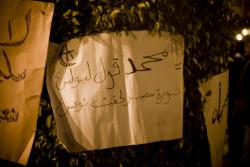Written by Lal Khan
Thursday, 03 February 2011
One
of the salient features of a revolution is that the masses conquer the
fear of the state and repression. This has been graphically demonstrated
on the streets of Egypt. At the same time the surge of a mass upheaval
breaks the taboos in the psychology of the soldiers and the army begins
to cleave on a class basis. A rare fraternity between the security
forces and the masses, whom they are supposed to crush, develops as the
revolution blossoms.
 January 30th – "Muslims and Christians united Against Mubarak" – Photo: 3arabwyAstonishing
January 30th – "Muslims and Christians united Against Mubarak" – Photo: 3arabwyAstonishing
scenes were witnessed in Cairo, the largest capital of the Arab world,
during the present uprising. Apart from the embraces of the soldiers on
the tanks, on January 31st 2011, a French built Gazelle of
the Egyptian Air Force flew low over the crowds probably with orders to
intimidate and frighten the masses on the streets from the military
elite. But the people cheered and waved at the fighter jet and the pilot
could be seen waving back from his cock-pit.
This revolutionary upsurge has defied all the sceptics and cynics on
the left and right who had written off revolutionary possibilities from
the political agenda. They were in for a shock. The wave of the revolt
pierced through the prevalent political setup of the pro-imperialist
liberal, secular and despotic regime of Mubarak and the Islamic
fundamentalist opposition of the Akhwan ul Muslimeen. As in Tunisia the
masses have rejected the notion spread by the mainstream media that the
only opposition to the pro-imperialist despots in the Middle East is
that of the Islamists. The presence of large numbers of red flags with
hammer and sickle in the demonstrations in Tunisia, Jordan, Yemen and
Egypt symbolised the left currents in these movements.
The present revolutionary upheaval in Egypt has been unleashed after
fifty nine years. In 1952 the corrupt and the despotic monarchy of King
Farouq was overthrown by radical left-wing officers with the backing of a
similar mass revolt. Jamal Abdul Nasser a pan-Arab socialist became the
president and embarked upon radical reforms. This triggered a whole
series of revolutionary changes throughout the Arab world. From Yemen to
Syria and from Algeria to Iraq and Sudan the right-wing despotic
regimes were toppled by these movements.
After the First World War the imperialist victors had divided the
single Arab nation by creating artificial states and boundaries to
perpetuate their plunder. For example, through the Sykes-Picot agreement
of 1916 the British and the French divided up among themselves the
control of Iraq, Syria, Jordan and Lebanon. Similarly through the
Balfour Declaration the British were given the mandate of setting up a
Jewish state in Palestine.
The upheavals in the aftermath of World War II led to revolts against
the imperialist stranglehold and exploitation in the Middle East. But
With the collapse of the Soviet Union and the capitalist degeneration of
the Chinese bureaucracy, most of the Proletarian Bonapartist regimes
also began to degenerate and imperialism was able to have a greater hold
in the region in the 1980’s and 1990’s.
 January 30th – Demonstrators in Tahrir square – Photo: 3arabwyThe
January 30th – Demonstrators in Tahrir square – Photo: 3arabwyThe
present uprisings are a turning point in the history of the region. In
Egypt and elsewhere the root cause of these movements are a rapidly
intensifying socio economic crisis, with steeply rising levels of
poverty, price hikes, unemployment and corruption. The seething hatred
of the masses against Mubarak and other despots of the region stems from
this aggravating exploitation and oppression.
The western intelligentsia and the media are trying to subvert the
real causes by substituting a political formula for a social content.
This will not solve anything. The imperialists are terrified by this
spontaneous upsurge of the oppressed Arab masses. A mainstream American
paper commented, “The U.S. supported Mubarak because of two fears: the
fear of another Khomeini and the fear of another Nasser. Both anxieties
remain entirely legitimate today.”
But Islamic fundamentalists and imperialists have been old
bedfellows. After all the Ikhwan was propped up and funded by the
Americans in the 1950’s to counter the threat of the abolishment of
capitalism in Egypt. El Baradei is a transitional figure and could be
used for western interests for a short span. It is probable that the CIA
is already in covert negotiations with the Brotherhood for a future set
up. But with the looming crisis of capitalism that won’t be much of a
solution for any kind of a stability in Egypt.
The Liberal secular rulers and the Islamic fundamentalists subscribe
to the same economics – capitalism. The capitalist crisis on a world
scale or in Egypt is not going to die out anytime soon. Hence the
possibility of any serious reforms for the masses does not exist.
However, revolutions of this intensity and dimension cannot go on
forever. The possibility of the derailing and the exhaustion of the
first wave of the upheaval cannot be ruled out. Even Mubarak could lurch
on for some time after this marvellous movement which was his nemesis.
The biggest tragedy for a dictatorial or autocratic regime is that it
pushes the consciousness of the masses back and creates illusions in
accidental figures and bourgeois democracy. This is more pertinent in a
situation where a revolutionary movement erupts without the presence of a
revolutionary party with a rock-solid ideological foundation, flexible
strategy and tactics and a steeled cadre organisation that can replace
the bourgeois state.
Unfortunately this is the case in Egypt at the present moment in
time. A revolutionary ferment is sweeping across the country and yet
there is the tragic absence of the subjective factor that could lead
this revolution to a socialist victory. Trotsky remarked in 1938, “The
historical crisis of mankind is reduced today to the crisis of the
revolutionary leadership”. How true this rings for the situation in the
Middle East and especially Egypt.
This means that the process will become more protracted and somewhat
convoluted. But this revolution has brought the situation beyond the
point of return. It won’t take another 59 years for a mass insurrection
to erupt. It is the beginning and not the end of a new period of class
struggle and revolutions. History is very economical. In the last three
decades of a relative lull in the class struggle the influence of
reformism and Stalinism has been cleansed from the workers’ movements by
history. A socialist transformation remains the only path to salvation
today.
